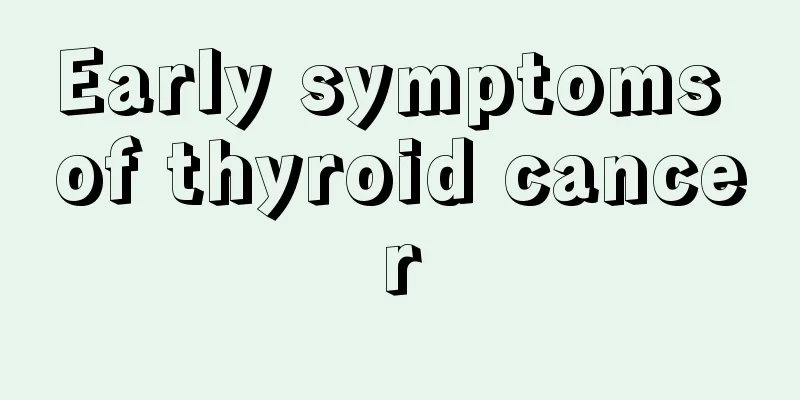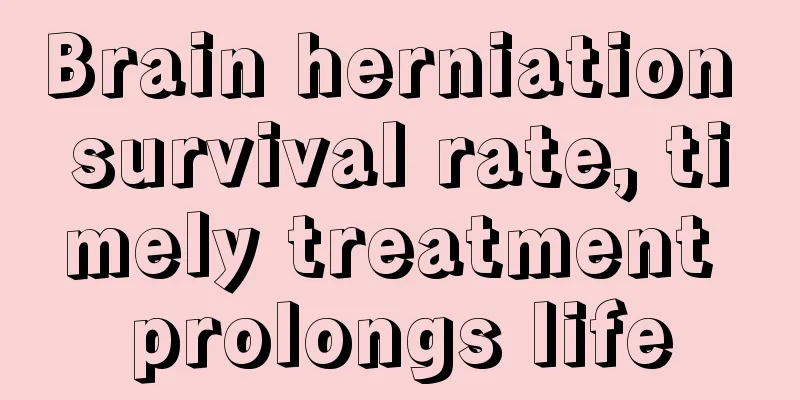What's wrong with the nodules on my neck? You need to know these

|
Nodules on the neck are medically called thyroid nodules, which are a common and frequent disease. Thyroid nodules are divided into benign and malignant types. They are mainly caused by thyroid hyperplasia, various thyroid inflammations, and "tumor-like" nodules. People need to pay attention and then make timely and scientific treatment when this disease occurs. 1. What is a thyroid nodule? A thyroid nodule refers to the abnormal local growth of thyroid cells, which forms a tumor. In layman's terms, it is a growth. A thyroid tumor needs to be confirmed by ultrasound examination before it can be diagnosed as a "thyroid nodule." Thyroid nodules can be said to be a relatively broad concept, including benign and malignant tumors of the thyroid gland. 2. Are thyroid nodules common? With the widespread use of thyroid color ultrasound and the development of color ultrasound technology, the detection rate of thyroid nodules has increased significantly. The probability of detecting thyroid nodules through palpation is 5%, while with the help of ultrasound, the detection rate of thyroid nodules can be as high as 30%~60%, of which only about 5% of thyroid nodules are malignant. In other words, many thyroid nodules may not be discovered in a lifetime if color ultrasound is not performed. In addition, very small nodules that could not be detected by color ultrasound in the past can now be detected. Benign thyroid nodules generally do not require treatment and only require regular check-ups. For thyroid nodules that are suspected of being cancerous or have grown rapidly in recent times, especially those with abnormal lymph nodes, further puncture examination or surgical treatment is required. 3. What causes thyroid nodules? A thyroid nodule is a lump located within the thyroid gland and is a symptom rather than a disease. There are many causes of thyroid nodules, mainly including three aspects. First, thyroid nodules are caused by thyroid hyperplasia; Secondly, nodules caused by various thyroid inflammations; The third aspect is the "tumor-like" nodules, which receive the most attention in daily life and have the greatest impact on health. What we are mainly talking about today is how to distinguish between these benign nodules and malignant nodules. 4. Which ones are benign and which ones are malignant? Thyroid nodules can be benign or malignant. Benign nodules generally do not require any treatment; malignant nodules are what we call thyroid cancer, including differentiated thyroid cancer, anaplastic cancer, and medullary cancer. Among them, the incidence of differentiated thyroid cancer is higher, which is divided into papillary thyroid cancer and follicular thyroid cancer. Compared with these types of nodules, the most harmful is malignant thyroid nodules, also known as thyroid cancer. 5. What are the symptoms of thyroid nodules? First of all, most people with thyroid nodules do not have any symptoms and are only discovered during color ultrasound during a health check-up. Larger lumps may appear on the front of the neck and on both sides of the thyroid gland. The lump is on the thyroid gland and moves up and down with swallowing. During the examination, we will find that if it is a benign nodule, the surface will generally be smooth, soft, mobile, and grow slowly; if it is a malignant nodule, the surface of the lump will not be so smooth, the texture will be hard, the mobility will be poor, and it will grow faster in a short period of time. In addition, malignant tumors are somewhat invasive and will invade surrounding organs. For example, invasion of the esophagus can cause difficulty in swallowing; invasion of the trachea can cause breathing disorders; invasion of the recurrent laryngeal nerve can cause hoarseness. Malignant thyroid nodules may also metastasize to the cervical lymph nodes, causing swollen cervical lymph nodes. 6. Which department of the hospital should I go to if I have thyroid nodules? If you have thyroid nodules, you should first see a thyroid specialist. Further examination and evaluation by a thyroid specialist will determine whether the thyroid nodule is benign or malignant and whether surgical treatment is required. 7. If you suspect you have a thyroid nodule, what tests should you do? If you suspect a thyroid nodule, you must first do two tests - a blood test for thyroid function and a thyroid color ultrasound and angiography. Thyroid color ultrasound and angiography are non-invasive examinations that do no harm to the human body. They are widely used and can be performed in most hospitals. If these two examinations cannot clarify the nature of the nodule, a fine needle aspiration of the thyroid gland, also known as fine needle aspiration cytology, will be required. 8. Under what circumstances is it necessary to perform thyroid puncture examination? In clinical practice, thyroid nodules with a diameter greater than 1 cm should be considered for thyroid puncture cytology examination. Thyroid nodules with a diameter of less than 1 cm are generally not recommended for puncture examination. However, if there is a high suspicion that the thyroid nodule is malignant: for example, ultrasound suggests that the nodule may be malignant; ultrasound of the cervical lymph nodes is abnormal; there is a history of neck radiation in childhood; there is a family history of thyroid cancer, etc., a puncture examination can also be considered. 9. Can the nature of the nodule be confirmed by a puncture? A puncture cannot completely confirm the nature of the nodule. Although fine needle aspiration of the thyroid is currently a relatively accurate method for evaluating the benign or malignant nature of thyroid nodules, it still has certain defects, and the probability of detecting malignant thyroid nodules is not 100%. Since fine needle aspiration of the thyroid cannot completely determine whether a nodule is benign or malignant, we must, when necessary, combine other examination methods for a comprehensive assessment to determine the nature of the nodule. 10. Can thyroid color ultrasound determine whether thyroid nodules are benign or malignant? With the clinical application of high-resolution ultrasound, experienced physicians can determine the nature of most thyroid nodules through B-ultrasound and angiography. Generally, malignant thyroid nodules will show the following in ultrasound and angiography: solid low echo; normal TSH but rich blood supply in the nodule; irregular nodule shape and irregular edges; tiny calcifications, pinpoint diffuse distribution or clustered calcifications in the nodule; accompanied by abnormal ultrasound images of cervical lymph nodes, etc. If these conditions occur, the thyroid nodule may be malignant and further examination is needed to determine the nature of the nodule. 11. If B-ultrasound shows calcification of nodules, does it mean cancer? When using ultrasound to determine whether a nodule is benign or malignant, calcification is an important reference indicator, but not the only one. Clinically, more than half of malignant thyroid nodules will calcify, especially gravel-like small calcifications or clustered calcifications. If the nodule calcification is relatively large, the chance of malignancy will be relatively lower, and about 10% to 20% may be thyroid cancer, among which follicular adenocarcinoma accounts for a larger proportion; if there is "punctate calcification" in the thyroid cyst, it may be caused by thyroid colloid deposition, and there is basically no possibility of cancer. Although calcification is an important reference indicator for cancer, a comprehensive judgment must also be made based on whether the nodule boundary is clear and the echo of the nodule. Thyroid cancer usually requires surgery. However, there is still some controversy about whether papillary thyroid microcarcinoma should be treated surgically. 12. Besides surgery, how else can thyroid cancer be treated? In addition to surgical treatment, endocrine therapy is also performed for the elderly or those who cannot tolerate surgery. Studies have found that TSH suppression therapy after thyroid cancer surgery can effectively inhibit the growth and recurrence of thyroid cancer. Iodine-131 is also widely used in the treatment of thyroid cancer. Iodine-131 treatment of thyroid cancer requires treatment of any remaining thyroid cancer cells and metastatic lesions after complete thyroid removal surgery. Surgical treatment, endocrine therapy and iodine-131 therapy in nuclear medicine are what we usually call the three pillars of thyroid cancer treatment. Through such a comprehensive treatment, the recurrence rate of thyroid cancer will be greatly reduced and the survival rate can be further improved. Although the incidence of thyroid cancer is increasing, due to the increased sensitivity of detection methods, most thyroid cancers are in the early stages and have a good prognosis. It is one of the most treatable cancers. Most of these tumors are very "mild" in nature and grow very slowly, and do not affect normal life and work. After standardized surgical treatment, the vast majority of thyroid cancer patients can achieve a satisfactory treatment effect. Through scientific and reasonable living and eating habits, you can stay away from thyroid cancer. |
<<: Why does the hard lump in the anus often cause pain?
>>: What is the best way to dredge lymphatic vessels?
Recommend
Placing these things in front of the computer is harmful to your health
Using a computer for a long time can easily harm ...
How to prevent and control termites
The topic of how to prevent and control termites ...
Fatigue and anemia are usually symptoms of colorectal cancer
Fatigue and anemia are usually symptoms of colore...
Taboos of soaking your feet with mugwort
I think everyone should be familiar with mugwort,...
Is platelet count 95 normal?
Platelets are one of the important components of ...
Under what circumstances can lung cancer not be operated on? Lung cancer is not suitable for surgery if it has these symptoms
Patients with multiple groups of fused mediastina...
Is scleroderma contagious? Prevention is important
Scleroderma is a systemic disease, but it is not ...
How harmful is thyroid cancer
How harmful is thyroid cancer? The thyroid gland ...
What is the function of ice muscle water?
In modern life, people like to use various cosmet...
How long is the appropriate amount of oxygen inhalation for altitude sickness?
The characteristic of the plateau is the high alt...
How to care for patients with advanced lung cancer? Correct care methods for advanced lung cancer
Lung cancer patients in the advanced stage are in...
How long does it take for the swelling of the forehead and eyes to go away
Many people are not very satisfied with their for...
What kind of sugarcane can't be eaten
For those who like to eat sugarcane, they should ...
What are the five major precautions for renal cysts
Renal cysts are relatively common in clinical pra...
Can yogurt be whipped into cream?
In fact, yogurt cannot be whipped into cream. Aft...









